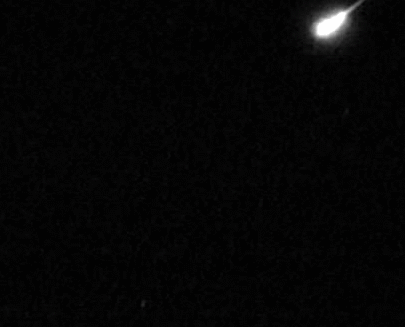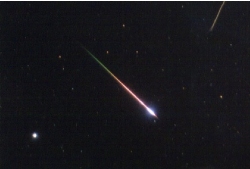Crestone
Weather Center
Crestone, Colorado

(photo courtesy of NASA)
Our next best meteor
shower show of 2025 will be
the
Orionids
(posted by Keno on 10/8/25)
The
next meteor shower to view
will be the Orionids, which
will beak in the early morning
hours of Wednesday, October 22
(with this peak show getting
started in the late evening of
October 21, just before
midnight). Look near the Orion
constellation, that being in
the direction of the
southeastern sky. About 20
meteors per hour will shoot
across the early morning sky
when it reaches its
zenithal hour,
with that occurring after
midnight,
according to NASA.
We will
have no moonlight getting in
the way of this fire show, as
this year's
Orionids
shower will occur during the
new moon phase, so that means dark skies
will make the shooting stars
easy to see for their
visit. The Orionids are considered to be one of the most beautiful showers of the year,
and
often produce fireballs, so
keep an eye out for bright
explosions of light. They are one of two meteor showers associated with Halley's Comet. The Orionids are so-named because the point they appear to come from, called the radiant, lies in the constellation Orion.
However, they can also be seen over a larger area
besides the southeastern sky,
too, but still, the
southeastern sky is the best
place to look for them.

- Meteor Showers in 2025 -
The dates in the table below are for the predawn hours in North America closest to the predicted peak of Earth’s passage through the meteoroid stream. Most showers are also active to some degree for a number of nights, sometimes on many nights, before and after the predicted peak date.
Important: The listed peak rate is what’s called the “zenithal hourly rate,” which is what a very lucky viewer would see under ideal conditions: a very dark sky free of moonlight or light pollution (stars of magnitude 6½ detectable naked-eye), with full dark adaptation and the radiant high overhead. Rarely are we so blessed, so most likely you’ll see lower rates than those listed.
| Shower | Radiant and its direction | Morning of maximum | Peak rate (per hour) |
Parent
comet or asteroid |
| Quadrantids | Boötes (NE) | Jan. 3 | 15-120+ | 2003 EH1 |
| Lyrids** | Lyra (E) | April 22 | 10-20+ | Thatcher |
| Eta Aquariids | Aquarius (E) | May 4 | 50 | 1P/Halley |
| Delta Aquariids | Aquarius (S) | July 25 to Aug. 5 | 20 | 96P/Machholz? |
| Alpha Capricornids | Alpha Capricorni (E) | July 29-30 | 5-10 | 169P/NEAT |
| Perseids** | Perseus (NE) | Aug. 12 | 100 | 109P/Swift-Tuttle |
| Orionids | Orion (SE) | Oct. 22, 23 | 20 | 1P/Halley |
| Taurids | Taurus (overhead) | Oct. and Nov. | 5-10 | 2P/Encke |
| Leonids | Leo (E) | Nov. 17 | 15 | 55P/Tempel-Tuttle |
| Geminids | Gemini (E) | Dec. 13 | 140 | 3200 Phaethon |
| Ursids | Ursa Minor (N) | Dec. 22 | 10 | 8P/Tuttle |
**Strong moonlight will interfere.
Number per hour max is for a moonless rural sky
|
There are meteor showers taking place every day/night of the year, but
many are hard to see. The meteor showers listed above are the easiest to
observe and provide the most activity. All of these showers are best seen after
midnight. Some are not even visible until after midnight. Particular attention
should be noted to the moonlight conditions. Showers that peak with
the moon at half or more full will be affected by the moonlight and will be
difficult to observe. While the dates noted above for when each shower is best seen
- remains
close to the same dates year after year, the moonlight conditions change considerably from
one year to the next. |